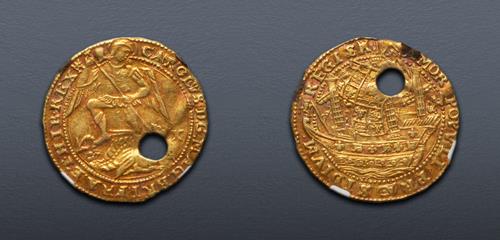|
STUART. Charles I. 1625-1649. AV Angel (26mm, 3.95 g, 7h). Fine gold coinage. Tower (London) mint; im: Moor’s head and castle/castle (over Moor’s head). Struck 1627-1628. CAROLVS · D · G · MAG · BRI · FRA · ET · HIB · REX (Moor’s head and castle), Archangel Michael slaying the Dragon; X to right / AMOR · POPVLI · PRESIDIVM · REGIS (castle over Moor’s head), three-masted ship sailing left; royal coat-of-arms on mainsail; hull ornamented with lis and lions passant. Schneider, Tower dies 0-2a/R-4a; Brooker 2 (same dies); Schneider 102 (same dies); North 2145; SCBC 2683A. Toned. In NGC encapsulation 2119532-038, graded AU Details, holed. Rare.
Ex Dr. Baumhauer Collection; Spink 67 (16 November 1988), lot 70; W.L. Raynes (Glendining, 15 February 1950), lot 220.
The association of disease with evil and the employment of the laying-on of hands to cure that disease/evil has been a part of human belief since at least the time of Jesus and the miracles associated with him. Among the numerous diseases that existed in medieval and modern Europe, one of the most heinous and virulent was the so-called morbium regis, or, as it was known in French, mal de roi – the King’s Evil. A form of scrofula, a tubercular infection of the lymph nodes that left untreated turned into suppurating sores. While various home remedies were known, the one perceived certain cure was the laying-on of hands by the king in his role as the anointed representative of Christ. Beginning in France under Robert II (996-1017) and in England under Edward the Confessor (1042-1066), this ritual became an important part of kingship and also a crucial test of royal legitimacy.
As a part of the ritual, the afflicted would receive a coin as alms. Because of its association with this ritual, the coin would be kept to act as a talisman for the sufferer. By the time of Edward IV, the coin used was a gold denomination, the angel, that was perfectly suited for the ceremony as it bore a depiction of the Archangel Michael slaying the Dragon on the obverse and the royal ship-of-state – an allusion to the monarch – on the reverse. Under Henry VII (1485-1509), the practice was ritualized into a Divine Service and the coins themselves were a central part of the ceremony, retaining their relative intrinsic purity. Having first been threaded with a ribbon for suspension, the coin would be passed over the affected areas by the monarch, who would sometimes make the sign of the cross with the coin as well. Even after England had become a Protestant country, Queen Elizabeth I (1558-1603) continued to do the latter.
Under the Stuarts, the ceremony took on special significance since they viewed it as an important component of their increasingly absolutist view of the divine right of kingship. While James I (1603-1625), owing to his Protestant background and the lack of such a ritual in Scotland, initially balked at performing the ritual, he soon acquiesced, although he removed everything in the ritual that remotely smacked of papism and invoked God in the actual healing. Under James I and Charles I (1625-1649), the coin itself underwent significant design changes to the reverse, including under Charles the replacement of the traditional legend with a more ironic one – AMOR POPVLI PRAESIDIVM REGIS (The People’s Love is the King’s Safeguard). Like his father, Charles I performed the ceremony only on Easter and Michaelmas, as well as on Progresses. In 1633, a few days after his Scottish Coronation, Charles touched about 100 people. To commemorate this event, special angels designed and struck by Nicholas Briot were used. During his captivity following the end of the Civil War, Charles continued to perform touchings; the coins and ribbons were supplied by those wanting to be touched.
Under the Commonwealth, both the denomination and the ceremony ceased. When the ritual was reintroduced during the Restoration of Charles II (1660-1685) and his successors, a gold medalet, now specifically a touch-piece, was created to replace the angel. Designed solely for the touching ceremony and not meant to be used as currency, this medalet continued to employ the designs of the former angel (although now the ship was now modernized by depicting the Sovereign of the Seas accompanied by the legend SOLI DEO GLORIA (Alone to God the glory). The last reigning monarch to touch on British soil was Anne (1702-1714), who did so three months before her death. The Hanoverians refused to participate at all and the ritual died out in England, although in France it did so until the execution of Louis XVI (1774-1793), and was continued by the Stuart Pretenders until the death of Cardinal Henry Benedict Stuart, Henry IX to the Jacobites, in 1807.
The final winners of all Triton XXVI lots will be determined at the live public sale that will be held on 10-11 January 2023.
Triton XXVI – Session Four – Lots 991-1315 will be held Wednesday afternoon, 11 January 2023 beginning at 2:00 PM ET.
Winning bids are subject to a 22.5% buyer's fee for bids placed on this website and 25% for all others.
We recognize that our users may have various Internet Browsers and Operating Systems. We like our visitors to have the best possible experience when using our bidding platform. However, we do recognize that it is impossible to develop applications that work identically, efficiently and effectively on all web browsers. The CNG bidding platform supports the latest stable major version and stable previous version of Chrome and Firefox.
|
